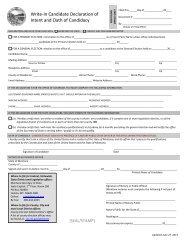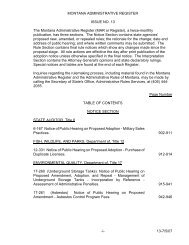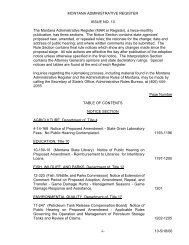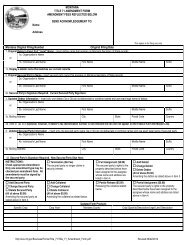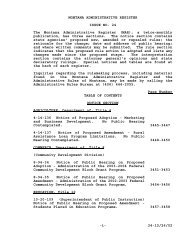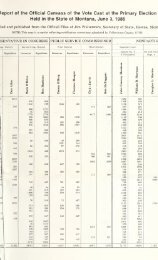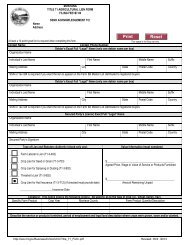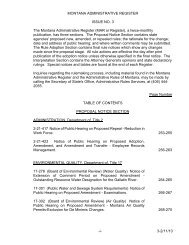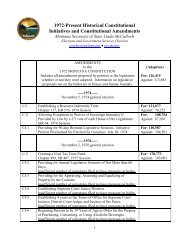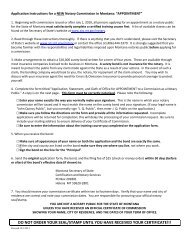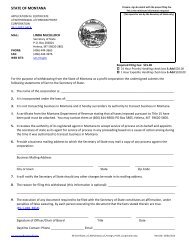Notary Handbook - the Montana Secretary of State Website
Notary Handbook - the Montana Secretary of State Website
Notary Handbook - the Montana Secretary of State Website
Create successful ePaper yourself
Turn your PDF publications into a flip-book with our unique Google optimized e-Paper software.
LEGAL WAYS TO IDENTIFY A PERSON FOR NOTARIAL PURPPOSES<br />
In <strong>the</strong> state <strong>of</strong> <strong>Montana</strong> <strong>the</strong>re are three ways that you may identify a person who requests a notarization:<br />
<br />
<br />
<br />
Personal Knowledge – A person whom you have known for a considerable period <strong>of</strong> time and would<br />
recognize anywhere, anytime can be identified on <strong>the</strong> basis <strong>of</strong> “personal knowledge.” This is a subjective<br />
standard, but a notary should be guided by <strong>the</strong> understanding that, in <strong>the</strong> event <strong>of</strong> a legal challenge to <strong>the</strong><br />
signer’s identity, <strong>the</strong> notary would have to positively identify <strong>the</strong> person in court, <strong>of</strong>ten many years after<br />
<strong>the</strong> notarization took place. <strong>Montana</strong> law views personal knowledge as <strong>the</strong> best form <strong>of</strong> identification,<br />
and thus requires no fur<strong>the</strong>r pro<strong>of</strong> <strong>of</strong> identity. In <strong>Montana</strong>, it is generally legal for a notary public to<br />
notarize <strong>the</strong> signature <strong>of</strong> a spouse or o<strong>the</strong>r relative as long as <strong>the</strong> notary is not personally named in <strong>the</strong><br />
document being signed or would be a direct beneficiary <strong>of</strong> <strong>the</strong> transaction contemplated by <strong>the</strong> document.<br />
The <strong>Secretary</strong> <strong>of</strong> <strong>State</strong>’s <strong>of</strong>fice cautions that notaries should seriously consider <strong>the</strong> potential conflicts that<br />
may arise over documents which transfer property or rights (titles, deeds, wills, powers <strong>of</strong> attorney, etc.)<br />
among family members. “Just because you can, doesn’t mean you should” are good words to apply in<br />
<strong>the</strong>se situations.<br />
Satisfactory Evidence – Pro<strong>of</strong> that you have positively identified a person who is o<strong>the</strong>rwise unknown, or<br />
only slightly known, to you is generally categorized as “satisfactory evidence.” The notary should request<br />
current, signed, and pictured ID before performing a notarization for someone <strong>the</strong>y do not know well.<br />
Acceptable forms <strong>of</strong> identification include a driver’s license, a military or student ID, a passport, or a<br />
government issued ID. Many times it will be necessary to use more than one piece <strong>of</strong> identification to<br />
conclusively identify a person. Notaries are cautioned to understand that some forms <strong>of</strong> ID, such as bank<br />
cards, credit cards, and non-pictured government-issued cards (social security or Medicare cards) are not<br />
acceptable as primary identifiers, although <strong>the</strong>y may in certain circumstances be used in conjunction with<br />
o<strong>the</strong>r ID to establish a person’s identity. Notaries are not expected to be authorities on all types <strong>of</strong><br />
identification, but <strong>the</strong>y are urged to use common sense and reasonable care when presented with<br />
identification that appears to have been altered or tampered with in any way, or when <strong>the</strong> picture or<br />
description <strong>of</strong> <strong>the</strong> person on <strong>the</strong> card does not match <strong>the</strong> person standing in front <strong>of</strong> <strong>the</strong> notary. If <strong>the</strong>re is<br />
any doubt as to <strong>the</strong> person’s identity, <strong>the</strong> only safe practice is to refuse to notarize any signature, oath, or<br />
acknowledgment.<br />
Credible Witness – The third means <strong>of</strong> identifying a person for notarial purposes is <strong>the</strong> most<br />
misunderstood, <strong>the</strong> most complicated, and <strong>the</strong> least likely to be available at <strong>the</strong> time <strong>the</strong> situation arises. A<br />
credible witness is only used when:<br />
• The signer is not personally known to <strong>the</strong> notary<br />
and<br />
• The signer has no acceptable form <strong>of</strong> ID<br />
Possible legitimate situations requiring a credible witness are:<br />
• Wallet or purse was lost or stolen and all IDs are missing.<br />
• A minor child who has no legal form <strong>of</strong> ID.<br />
• A person is unexpectedly in a hospital or o<strong>the</strong>r institution.<br />
The credible witness must be:<br />
<br />
<br />
<br />
Personally known to <strong>the</strong> notary.<br />
Personally known to <strong>the</strong> signer.<br />
An unbiased third party who has no interest in, or benefit from, <strong>the</strong> transaction.<br />
When using a credible witness for identification, three people are toge<strong>the</strong>r at <strong>the</strong> time <strong>of</strong> <strong>the</strong> notarization<br />
and nobody is using an ID card for identification.<br />
7



